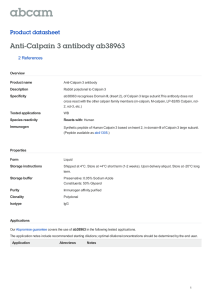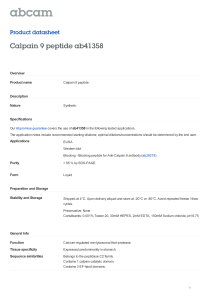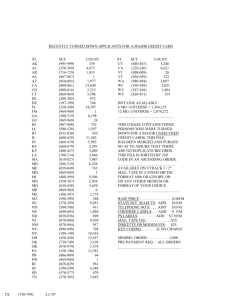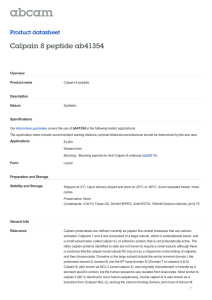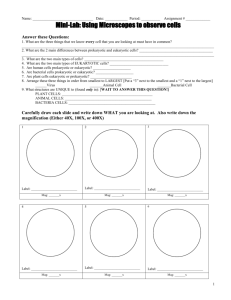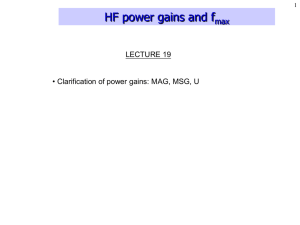,1
advertisement
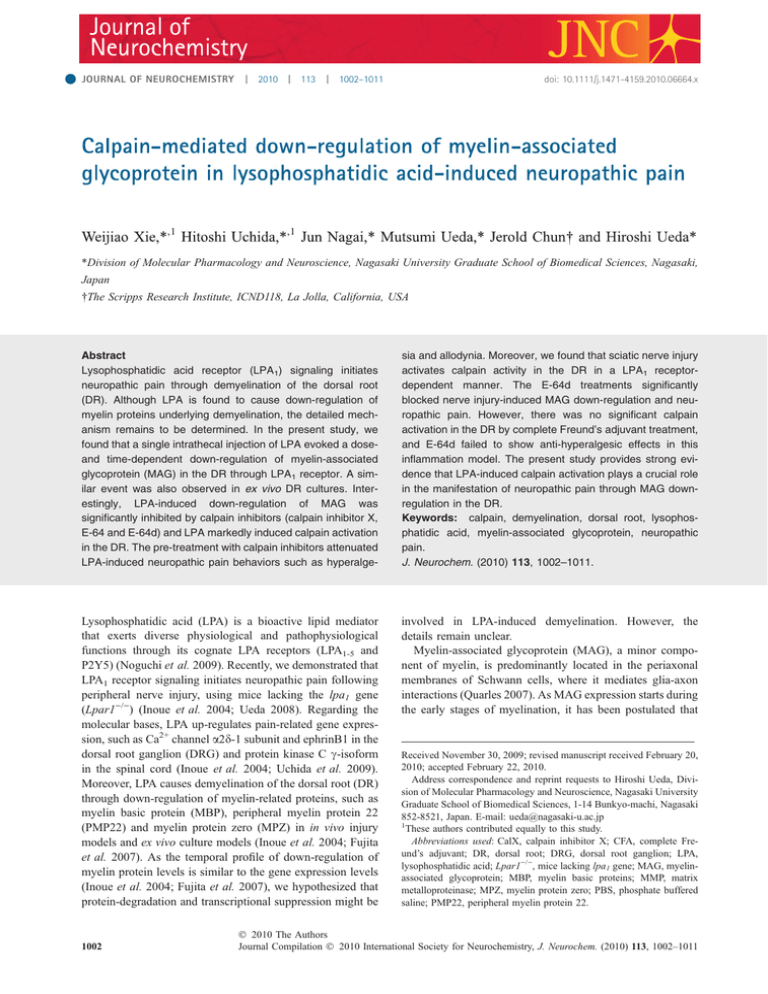
JOURNAL OF NEUROCHEMISTRY ,1 | 2010 | 113 | 1002–1011 doi: 10.1111/j.1471-4159.2010.06664.x ,1 *Division of Molecular Pharmacology and Neuroscience, Nagasaki University Graduate School of Biomedical Sciences, Nagasaki, Japan The Scripps Research Institute, ICND118, La Jolla, California, USA Abstract Lysophosphatidic acid receptor (LPA1) signaling initiates neuropathic pain through demyelination of the dorsal root (DR). Although LPA is found to cause down-regulation of myelin proteins underlying demyelination, the detailed mechanism remains to be determined. In the present study, we found that a single intrathecal injection of LPA evoked a doseand time-dependent down-regulation of myelin-associated glycoprotein (MAG) in the DR through LPA1 receptor. A similar event was also observed in ex vivo DR cultures. Interestingly, LPA-induced down-regulation of MAG was significantly inhibited by calpain inhibitors (calpain inhibitor X, E-64 and E-64d) and LPA markedly induced calpain activation in the DR. The pre-treatment with calpain inhibitors attenuated LPA-induced neuropathic pain behaviors such as hyperalge- sia and allodynia. Moreover, we found that sciatic nerve injury activates calpain activity in the DR in a LPA1 receptordependent manner. The E-64d treatments significantly blocked nerve injury-induced MAG down-regulation and neuropathic pain. However, there was no significant calpain activation in the DR by complete Freund’s adjuvant treatment, and E-64d failed to show anti-hyperalgesic effects in this inflammation model. The present study provides strong evidence that LPA-induced calpain activation plays a crucial role in the manifestation of neuropathic pain through MAG downregulation in the DR. Keywords: calpain, demyelination, dorsal root, lysophosphatidic acid, myelin-associated glycoprotein, neuropathic pain. J. Neurochem. (2010) 113, 1002–1011. Lysophosphatidic acid (LPA) is a bioactive lipid mediator that exerts diverse physiological and pathophysiological functions through its cognate LPA receptors (LPA1-5 and P2Y5) (Noguchi et al. 2009). Recently, we demonstrated that LPA1 receptor signaling initiates neuropathic pain following peripheral nerve injury, using mice lacking the lpa1 gene (Lpar1)/)) (Inoue et al. 2004; Ueda 2008). Regarding the molecular bases, LPA up-regulates pain-related gene expression, such as Ca2+ channel a2d-1 subunit and ephrinB1 in the dorsal root ganglion (DRG) and protein kinase C c-isoform in the spinal cord (Inoue et al. 2004; Uchida et al. 2009). Moreover, LPA causes demyelination of the dorsal root (DR) through down-regulation of myelin-related proteins, such as myelin basic protein (MBP), peripheral myelin protein 22 (PMP22) and myelin protein zero (MPZ) in in vivo injury models and ex vivo culture models (Inoue et al. 2004; Fujita et al. 2007). As the temporal profile of down-regulation of myelin protein levels is similar to the gene expression levels (Inoue et al. 2004; Fujita et al. 2007), we hypothesized that protein-degradation and transcriptional suppression might be involved in LPA-induced demyelination. However, the details remain unclear. Myelin-associated glycoprotein (MAG), a minor component of myelin, is predominantly located in the periaxonal membranes of Schwann cells, where it mediates glia-axon interactions (Quarles 2007). As MAG expression starts during the early stages of myelination, it has been postulated that 1002 Received November 30, 2009; revised manuscript received February 20, 2010; accepted February 22, 2010. Address correspondence and reprint requests to Hiroshi Ueda, Division of Molecular Pharmacology and Neuroscience, Nagasaki University Graduate School of Biomedical Sciences, 1-14 Bunkyo-machi, Nagasaki 852-8521, Japan. E-mail: ueda@nagasaki-u.ac.jp 1 These authors contributed equally to this study. Abbreviations used: CalX, calpain inhibitor X; CFA, complete Freund’s adjuvant; DR, dorsal root; DRG, dorsal root ganglion; LPA, lysophosphatidic acid; Lpar1)/), mice lacking lpa1 gene; MAG, myelinassociated glycoprotein; MBP, myelin basic proteins; MMP, matrix metalloproteinase; MPZ, myelin protein zero; PBS, phosphate buffered saline; PMP22, peripheral myelin protein 22. 2010 The Authors Journal Compilation 2010 International Society for Neurochemistry, J. Neurochem. (2010) 113, 1002–1011 Crucial role of calpain in neuropathic pain | 1003 MAG is crucial for initiation of the myelination process (Owens and Bunge 1989; Paivalainen and Heape 2007; Quarles 2009). Moreover, the sustained expression of MAG, at relatively high levels, in adulthood is also assumed to play a key role in the maintenance of myelin integrity (Garbay et al. 2000; Schachner and Bartsch 2000; Quarles 2009). In addition, MAG-mediated signaling from glia to axons is known to maintain the structural integrity of myelinated axons by modulating the axonal cytoskeleton and inhibiting the outgrowth of neuronal processes (sprouting) through interactions with Nogo receptors, gangliosides (such as GD1a and GT1b) and paired immunoglobulin-like receptor B (Atwal et al. 2008; Filbin 2008; Quarles 2009; Schnaar and Lopez 2009). Given the involvement of MAG in myelination and sprouting, we hypothesize that MAG down-regulation may play a key role in LPA-induced neuropathic pain conditions. Therefore, we attempted to examine whether LPA affects MAG expression levels in the DR. Here, we report that LPA activates calpain to down-regulate MAG expression through the LPA1 receptor in the DR, thereby causing neuropathic pain. Materials and methods Animals and surgery Male mice lacking the lpa1 gene (Lpar1)/)) (Contos et al. 2000) and wild type C57BL/6J mice weighing 20–24 g were used. They were kept in a room with a temperature of 21 ± 2C with free access to standard laboratory diet and tap water. All procedures were approved by the Nagasaki University Animal Care Committee and complied with the recommendations of the International Association for the Study of Pain (Zimmermann 1983). Partial ligation of the sciatic nerve was performed under pentobarbital (50 mg/kg) anesthesia, following the methods of Malmberg and Basbaum (Malmberg and Basbaum 1998). Drugs Lysophosphatidic acid (1-oleoyl-2-hydroxy-sn-3-glycerol-3-phosphate) and 1,10-phenanthroline were purchased from Sigma-Aldrich (St. Louis, MO, USA). Calpain inhibitor X (CalX; Z-Leu-AbuCONH-ethyl) and epoxomicin were from Calbiochem (San Diego, CA, USA). z-valine-alanine-aspartate (zVAD)-fmk (carbobenzoxyL-valyl-L-alanyl-b-methyl-L-aspart-1-yl-fluoromethane) was from Peptide Institute, Inc. (Osaka, Japan). p-APMSF [(p-amidinophenyl) methanesulfonyl fluoride hydrochloride] and complete Freund’s adjuvant (CFA) were from Wako Pure Chemical Industries, Ltd. (Osaka, Japan). E-64 ([(2S,3S)-3-Carboxyoxirane-2-carbonyl]-Lleucine (4-guanidinobutyl) amide hemihydrate) and E-64d [(2S,3S)-trans-Epoxysuccinyl-L-leucylamido-3-methylbutane ethyl ester] were kindly provided by the Taisho Pharmaceutical Co., Ltd. (Saitama, Japan). Drug injection Lysophosphatidic acid and CalX were dissolved in artificial CSF (aCSF; 125 mM NaCl, 3.8 mM KCl, 1.2 mM KH2PO4, 26 mM NaHCO3, 10 mM glucose, pH 7.4). E-64d was dissolved in 100% dimethylsulfoxide as a stock solution, and diluted in saline prior to administration. The intrathecal (i.t.) injection was administered into the space between the spinal L5 and L6 segments according to the method of Hylden and Wilcox (Hylden and Wilcox 1980). The intrathecal injection of CalX or intravenous (i.v.) injection of E-64d into the tail vein was performed 30 min prior to LPA treatment. The intraplantar (i.pl.) injections were given using a Hamilton microsyringe connected to polyethylene tubing with a 30-gauge hypodermic needle. Peripheral inflammation was induced by CFA (20 lL i.pl.) injection. In nerve injury and peripheral inflammation models, E-64d (i.v.) was injected twice a day (12-h interval) for 3 days, starting from 30 min prior to nerve injury and CFA injection. Nociception test In the thermal paw withdrawal test, the nociception threshold was evaluated as the latency to withdraw a paw upon a thermal stimulus (Hargreaves et al. 1988; Ma et al. 2009). Unanesthetized animals were placed in Plexiglas cages on top of a glass sheet and an adaptation period of 1 h was allowed. A thermal stimulator (IITC Inc., Woodland Hills, CA, USA) was positioned under the glass sheet and the focus of the projection bulb was aimed exactly at the middle of the plantar surface of the animal. A mirror attached to the stimulator permitted visualization of the plantar surface. A cut-off time of 20 s was set to prevent tissue damage. The mechanical paw pressure test was performed as described previously (Inoue et al. 2004; Matsumoto et al. 2006). Briefly, mice were placed in a plexiglas chamber on a 6 · 6 mm wire mesh grid floor and allowed to acclimatize for a period of 1 h. A mechanical stimulus was then delivered to the middle of the plantar surface of the right-hind paw using a Transducer Indicator (Model 1601; IITC Inc.). The amount of pressure that induced a flexor response was defined as the pain threshold. A cut-off pressure of 20 g was set to avoid tissue damage. In these experiments using mechanical and thermal tests, the thresholds were determined from three repeated challenges at 10-min intervals, and the averages of responses were evaluated. Western blot According to manufacturer’s instructions, non-reduced protein was used for the detection of MAG, and reduced protein was used for btubulin. Total protein (20 lg) extracted from L4–5 DRs was separated on SDS-polyacrylamide gels (12%). Primary antibodies were used at the following dilutions: mouse anti-MAG antibody (1 : 5000; Chemicon, Temecula, CA, USA) and rabbit anti-btubulin polyclonal antibody (1 : 500; Santa Cruz Biotechnology, Santa Cruz, CA, USA). Horseradish peroxidase-labeled anti-mouse IgG and horseradish peroxidase-labeled anti-rabbit IgG were used as secondary antibodies at dilutions of 1 : 1000. Immunoreactive bands were detected using an enhanced chemiluminescent substrate (SuperSignal West Pico Chemiluminescent Substrate; Pierce Chemical, Rockford, IL, USA). Ex vivo DR cultures Ex vivo DR cultures were performed as described previously (Fujita et al. 2007). Briefly, the L4–5 DRs with DRG were isolated by carefully removing the spinal vertebra without tearing. The tissue was washed with ice-cold phosphate buffered saline (pH 7.4, PBS) containing penicillin and streptomycin, and placed in Dulbecco’s modified Eagle’s medium without serum. The culture was carried 2010 The Authors Journal Compilation 2010 International Society for Neurochemistry, J. Neurochem. (2010) 113, 1002–1011 1004 | W. Xie et al. out at 37C in the presence of 5% CO2. Protease inhibitors were added 30 min prior to LPA treatment (1 lM). Determination of calpain activity Calpain activities in protein lysates from L4–5 DR, DRG and spinal dorsal horn were analyzed using a commercially available calpain activity assay kit (BioVision, Mountain View, CA, USA) according to the manufacturer’s instructions. This method is based on the detection of the fluorometric cleavage of the calpain substrate Ac-leucine-leucine-tyrosine-7-amino-trifluoromethyl coumarin, which emits blue light (400 nm). Upon cleavage of the substrate by calpain, free 7-amino-trifluoromethyl coumarin (AFC), which emits yellow-green fluorescence (505 nm), was quantified using a 1420 ARVOMX/Light fluorescent plate reader (PerkinElmer Japan Co., Ltd, Yokohama, Japan). Immunostaining for MAG Mice were deeply anesthetized with sodium pentobarbital (50 mg/ kg i.p.), and perfused with potassium-free PBS (K+-free PBS, pH 7.4), followed by 4% paraformaldehyde solution. The L4–5 DRs were isolated, post-fixed for 3 h, and cryoprotected overnight in 25% sucrose solution. The DRs were fast-frozen in cryoembedding compound on a mixture of ethanol and dry ice and stored at )80C until ready for use. The DRs were sectioned at a thickness of 10 lm, thaw-mounted on silane-coated glass slides, and air-dried overnight at 25C. The DR sections were incubated with blocking buffer containing anti-mouse IgG (1 : 50; Zymed, South San Francisco, CA, USA) and 4% bovine serum albumin in 0.1% Triton X-100 in K+-free PBS, and then incubated with antiMAG antibody (1 : 300) overnight at 4C. After washing, sections were incubated with Alexa Fluor 488-conjugated anti-mouse IgG (1 : 1000; Molecular Probes, Carlsbad, CA, USA) secondary antibody for 2 h at 25C. The MAG-immunoreactivity was detected by automatic fluorescence microscopy using BZ Image Measurement software (Bio-Zero, Keyence, Tokyo, Japan). Statistical analysis In Figs 3(b), 4(a), 5, 6, 7 and 8(b), the differences between multiple groups were analyzed by one-way ANOVA with Tukey-Kramer multiple comparison post-hoc analysis. In Fig. 1, 3(a) and 8(a), data (a) were analyzed using the Student’s t-test. The criterion of significance was set at p < 0.05. Results are expressed as the mean ± SEM. Results Down-regulation of MAG protein expression by LPA Previously, we have reported that LPA (1 nmol i.t.) induces demyelination of the DR 24 h post-injection (Inoue et al. 2004). Using western blot analysis, we found that intrathecal injection of LPA dose-dependently down-regulates MAG protein expression in the DR from 0.1 to 10 nmol at 24 h post-injection (Fig. 1a). The most prominent reduction was observed at a dose of 10 nmol (Fig. 1a), which exerts no abnormal behavior. The MAG expression levels were slightly but not significantly reduced at 3 h after LPA injection (10 nmol i.t.), however, a significant decrease in MAG levels occurred at 12 h post-injection (Fig. 1b). Maximal reduction was observed at 24 h post-injection (Fig. 1b). While the significant reduction was still observed at day 3 postinjection, it was moderate but not significant at day 7 postinjection (Fig. 1b). These results suggest that LPA induces rapid down-regulation of MAG protein expression in the DR. Lack of MAG down-regulation in Lpar1)/) mice In the peripheral nervous system, MAG expression has been found abundantly in paranodal regions and to a lesser extent in periaxonal Schwann cell membranes (Georgiou et al. 2004). Consistent with this previous study, immunohistochemical analysis revealed that strong MAG signals are located in paranodal regions and weaker ones along the axons in the DR of vehicle-treated wild type mice (Fig. 2a). LPA (10 nmol i.t.) caused a marked reduction of MAG signals at 24 h post-injection (Fig. 2b). On the other hand, the MAG signals seen in vehicle-treated Lpar1)/) mice were comparable to that of vehicle-treated wild type mice (Fig. 2c). In contrast, the LPA-induced down-regulation of (b) Fig. 1 LPA-induced down-regulation of MAG protein expression in the DR. The expression levels of MAG protein in the DR were assessed by western blot analysis. (a) Dose-dependent down-regulation of MAG by intrathecal injection of LPA at 24 h postinjection. (b) Time-course of LPA-induced (10 nmol i.t.) down-regulation of MAG. Photograph shows representative data. Results are normalized to b-tubulin protein expression levels, and expressed as percentage of the levels in the vehicle (Veh)treated group. *p < 0.05, vs. Veh-treated group. Data represent the means ± SEM from at least three mice. 2010 The Authors Journal Compilation 2010 International Society for Neurochemistry, J. Neurochem. (2010) 113, 1002–1011 Crucial role of calpain in neuropathic pain | 1005 (a) (b) (c) (d) Fig. 2 LPA1 receptor-dependent downregulation of MAG in the DR. MAG protein expression at 24 h after injection of Veh (a and c) or LPA (10 nmol i.t.) (b and d) was assessed by immunohistochemical analysis. Wild type (WT; a and b) and Lpar1)/) (c and d) mice were used. Photographs show representative data. Scale bar = 20 lm. MAG was absent in Lpar1)/) mice (Fig. 2d), suggesting that the LPA1 receptor is crucial for MAG down-regulation in the DR by LPA. Protease-mediated MAG down-regulation Using ex vivo cultures of DR, we have demonstrated that LPA causes demyelination of DR via the down-regulation of MBP and MPZ at 24 h post-treatment (Fujita et al. 2007). Thus, we assessed whether LPA down-regulates MAG expression in cultures of DR. Western blot analysis revealed that treatment with LPA (1 lM) for 24 h causes a significant reduction of MAG protein expression (Fig. 3a). As z-valinealanine-aspartate (zVAD)-fmk (1 lM), a broad spectrum caspase inhibitor, had no effect on LPA-induced downregulation of MAG (Fig. 3b), it is unlikely that LPA causes apoptotic cell death of Schwann cells in the DR. To test the involvement of protease-mediated protein degradation in LPA-induced down-regulation of MAG, we used various protease inhibitors such as E-64 (100 lM) for calpains and other cysteine proteases (Ray et al. 2003), CalX (10 lM) for calpains (James et al. 1998), epoxomicin (5 lM) for proteasomes, (p-amidinophenyl) methanesulfonyl fluoride hydrochloride (1 lM) for serine proteases and 1,10-phenanthroline (100 lM) for matrix metalloproteinases (MMP). For all inhibition studies, cultures were treated with inhibitors 30 min prior to LPA exposure. The inhibitors alone had no effect on the MAG expression levels in the vehicle-treated DR cultures (data not shown). Among these inhibitors, only the calpain inhibitors (CalX and E-64) significantly blocked LPA-induced down-regulation of MAG (Fig. 3b), suggesting that calpain is a plausible mediator of MAG degradation by LPA in the DR. Blockade of LPA-induced down-regulation of MAG by calpain inhibitors We examined whether calpain is involved in LPA-induced down-regulation of MAG in the DR in vivo. For in vivo studies, we used E-64d, an esterified and more cell-permeable analog of E-64 (Ray et al. 2003). Western blot analysis revealed that pre-treatment with CalX (10 nmol i.t.) or E-64d (1.5 mg/kg i.v.) 30 min prior to LPA injection (10 nmol i.t.) completely blocked LPA-induced down-regulation of MAG (Fig. 4a). Similar results were obtained with immunohistochemical analysis (Fig. 4b–e). These results suggest that calpain plays a key role in LPA-induced down-regulation of MAG. LPA-induced calpain activation To obtain direct evidence for the activation of calpain by LPA, we assessed calpain activity in the DR in vivo. We isolated L4–5 DRs 24 h after LPA injection (10 nmol i.t.), and measured calpain activity in extracted protein from DRs using a fluorometric assay. We found that LPA significantly up-regulated calpain activity, and that pre-treatment with CalX (10 nmol i.t.) or E-64d (1.5 mg/kg i.v.) completely blocked the activation (Fig. 5). In contrast, CalX or E-64d alone had no effect on calpain activity in the vehicle-treated DRs (data not shown). Attenuation of LPA-induced neuropathic pain behaviors by calpain inhibitors Next, we assessed whether calpain inhibitors could block LPA-induced neuropathic pain-like behaviors, such as thermal hyperalgesia and mechanical allodynia. Consistent with previous data (Inoue et al. 2004), LPA (10 nmol i.t.) 2010 The Authors Journal Compilation 2010 International Society for Neurochemistry, J. Neurochem. (2010) 113, 1002–1011 1006 | W. Xie et al. (a) (b) Fig. 3 LPA-induced down-regulation of MAG in ex vivo DR cultures. MAG expression in ex vivo cultures of DR at 24 h after LPA treatment (1 lM) was assessed by western blot analysis. (a) LPA-induced downregulation of MAG. (b) Effects of various protease inhibitors on LPAinduced down-regulation of MAG. The concentration of each inhibitor was as follows: CalX (10 lM), E-64 (100 lM), epoxomicin (Epo, 5 lM), p-APMSF (AP, 1 lM), 1,10-phenanthroline (Phe, 100 lM), (a) zVAD-fmk (zVAD, 1 lM). Photograph shows representative data. Results are normalized to b-tubulin protein expression levels, and expressed as a percentage of the levels in non-treated control groups (Cont) (a) or Veh-Veh-treated group (b). *p < 0.05 vs. Veh-treated group (a) or Veh-Veh-treated group (b) and #p < 0.05 vs. Veh-LPAtreated group. Data represent the means ± SEM from at least five mice. (b) (c) (d) (e) Fig. 4 Inhibition of LPA-induced down-regulation of MAG by calpain inhibitors. Blockade of LPA-induced (10 nmol i.t.) down-regulation of MAG by CalX (10 nmol i.t.) or E-64d (1.5 mg/kg i.v.) at 24 h postinjection in vivo, assessed by western blot (a) and immunohistochemical analysis (b–e). (a) Results are normalized to b-tubulin protein expression levels, and expressed as a percentage of the levels in the Veh-aCSF-treated group. *p < 0.05 vs. Veh-aCSF-treated group and #p < 0.05 vs. Veh-LPA-treated group. Data represent the means ± SEM from at least four mice. Photograph shows representative data. Scale bar = 20 lm. significantly reduced the thermal and mechanical pain thresholds during day 1–7 post-injection (Fig. 6a–d). Pretreatment with CalX (10 nmol i.t.) showed a partial but significant inhibition of LPA-induced thermal hyperalgesia and mechanical allodynia (Fig. 6a and b). In contrast, CalX alone had no effects on pain thresholds in vehicle-treated mice (Fig. 6a and b). Similar results were obtained with E64d (Fig. 6c and d). These results suggest that the calpainmediated protein degradation system plays a key role in LPA-induced neuropathic pain behaviors. 2010 The Authors Journal Compilation 2010 International Society for Neurochemistry, J. Neurochem. (2010) 113, 1002–1011 Crucial role of calpain in neuropathic pain | 1007 Discussion Fig. 5 Increase in calpain activity by LPA in the DR. Calpain activity in the DR was assessed at 24 h after LPA injection (10 nmol i.t.). Veh, CalX (10 nmol i.t.) or E-64d (1.5 mg/kg i.v.) were injected 30 min prior to aCSF or LPA. Results are expressed as a percentage of the Veh-aCSF-treated group. *p < 0.05 vs. Veh-aCSF-treated group and #p < 0.05 vs. Veh-LPA-treated group. Data represent the means ± SEM from at least three mice. Critical role of calpain activation in sciatic nerve injuryinduced neuropathic pain, but not in CFA-induced inflammatory pain The intrathecal injection of LPA has been found to mimic the peripheral nerve injury-induced neuropathic pain and its underlying mechanisms (Inoue et al. 2004; Ueda 2006, 2008). Therefore, we next examined whether nerve injury activates calpain in the DR, thereby causing MAG downregulation and neuropathic pain behaviors. As shown in Fig. 7(a), nerve injury markedly up-regulated calpain activity in the DR during 1–3 days post-injury. We found that nerve injury-induced calpain activation is absent in LPA1-deficient mice (Fig. 7b), suggesting the critical contribution of LPA1 receptor signaling. Moreover, when mice were treated E-64d for 3 days starting from 30 min prior to injury, nerve injuryinduced calpain activation at day 1 post-injury (Fig. 7a) and MAG-down-regulation at day 7 post-injury were significantly blocked (Fig. 7c and d). In addition, these treatments also partially, but significantly, prevented the development of thermal hyperalgesia after nerve injury (Fig. 7e). On the other hand, peripheral inflammation is reported to cause calpain activation in the DRG and spinal cord (Pareek et al. 2006). When CFA was given intraplantarly, the calpain activity was significantly increased in the spinal dorsal horn, partially increased in the DRG, but not in the DR (Fig. 8a). We found that the treatments with E-64d have no effect on the manifestation of CFA-induced thermal hyperalgesia (Fig. 8b). We have reported that LPA1 signaling is crucial for the initiation of nerve injury-induced neuropathic pain, which is in part mediated through demyelination of the DR (Inoue et al. 2004; Fujita et al. 2007). Transcriptional suppression of myelin-related genes, such as MBP and PMP22, has been assumed to contribute to LPA-induced demyelination (Ueda 2006, 2008). In the present study, we provide the first evidence that LPA down-regulates MAG expression in the DR through the calpain-mediated protein degradation system. In addition to MBP, PMP22 and MPZ (Inoue et al. 2004; Fujita et al. 2007), the present study clarified that MAG is a novel target for LPA1 receptor signaling. The dose-range required for LPA-induced down-regulation of MAG in both in vivo and ex vivo experiments was comparable to that for the down-regulation of other myelin proteins (Inoue et al. 2004; Fujita et al. 2007). Moreover, LPA-induced downregulation of MAG was found to commence at 3 h postinjection, and reached a maximal level at 24 h post-injection. This time-course was comparatively similar to LPA-induced down-regulation of MBP in ex vivo experiments (Fujita et al. 2007). We have reported that LPA mimics nerve-injuryinduced neuropathic pain, and that nerve injury-induced down-regulation of MBP and PMP22 are LPA1 receptordependent (Inoue et al. 2004; Ueda 2008). Consistent with these findings, the present study showed that nerve injury activates calpain in the DR through LPA1 receptor, thereby causing MAG down-regulation. Calpain is a cytoplasmic cysteine protease that plays a key role in physiological and pathophysiological conditions in the nervous system (Camins et al. 2006; Vosler et al. 2008). A large number of proteins are known as calpain substrates, including myelin proteins such as MAG and MBP (Vosler et al. 2008). Calpain-mediated down-regulation of MAG and MBP has been found in demyelinating diseases such as multiple sclerosis (Inuzuka et al. 1987; Shields and Banik 1999; Vosler et al. 2008). The present study provides the first evidence that LPA down-regulates MAG protein expression in the DR in a calpain-dependent manner, using in vivo and ex vivo experiments. While MMP is reported to degrade MAG as well as MBP (Gijbels et al. 1993; Proost et al. 1993; D’Souza and Moscarello 2006; Milward et al. 2008), LPA-induced down-regulation of MAG was insensitive to the MMP inhibitor. Moreover, we found that LPA markedly induces calpain activity in the DR, using a fluorometric assay. It is well known that calpain is activated by calcium (Goll et al. 2003; Vosler et al. 2008), however, further studies are required for the elucidation of the mechanisms underlying LPA-induced calpain activation in the DR. Using behavioral studies, we found that calpain-mediated protein degradation is involved in LPA- and nerve injuryinduced neuropathic pain behaviors. The fact that LPA- and 2010 The Authors Journal Compilation 2010 International Society for Neurochemistry, J. Neurochem. (2010) 113, 1002–1011 1008 | W. Xie et al. Fig. 6 Partial blockade of LPA-induced neuropathic pain by calpain inhibitors. Blockade of LPA-induced (10 nmol i.t.) thermal hyperalgesia and allodynia by CalX (a and b) and E-64d (c and d). After LPA injection, (a and c) thermal paw withdrawal latencies (PWL) in seconds were measured using the thermal paw withdrawal test, and (b and d) mechanical paw withdrawal thresholds (PWT) in grams were measured using the paw pressure test. *p < 0.05 vs. Veh-aCSF-treated group and #p < 0.05 vs. Veh-LPA-treated group. Data represent the means ± SEM from five mice. nerve injury-induced abnormal pain were partially blocked by calpain inhibitors indicates the presence of other mechanisms induced by LPA. In this context, we have recently identified genes, that are immediately induced by LPA1 receptor signaling in the DRG (Uchida et al. 2009). One of these, ephrinB1, has been found to play a crucial role in LPAinduced neuropathic pain through activation of the N-methylD-aspartate receptor in the spinal cord (Uchida et al. 2009). In addition, calpain is reported to mediate early cytokine expression in the DRG, including tumor necrosis factor-a and interleukin-1b after nerve injury (Uceyler et al. 2007). Therefore, it is possible that LPA might induce calpain activation in the DRG, thereby causing neuropathic pain. However, the details remain to be determined. On the other hand, calpain is found to be activated in the DRG and spinal cord after peripheral inflammation, and implicated in the sensitization of nociceptive neurons through the cleavage of neurofilament light chain and p35, an activator of cyclin-dependent kinase 5 (Kunz et al. 2004; Pareek et al. 2006). The present study showed that CFA induces calpain activation in the spinal dorsal horn and partially in the DRG. In contrast, CFA-induced calpain activation was absent in the DR, indicating the clear difference in the underlying mechanisms between neuropathic pain and inflammatory pain. Similarly, E-64d, a calpain inhibitor, markedly attenuated the neuropathic pain, but not CFA-induced chronic inflammatory pain, though there is a report that different type of calpain inhibitor shows a weak attenuation of acute inflammatory pain induced by zymosan (Kunz et al. 2004). Further study to examine the role of calpain activation in the manifestation of acute and chronic inflammatory pain would be the next subject. The pathological consequences of LPA-induced downregulation of MAG in the DR remain elusive. In addition to MBP, PMP22 and MPZ, MAG is crucial for the maintenance of myelination (Garbay et al. 2000). While MBP, PMP22 and MPZ are localized in compact myelin, MAG is localized in the non-compacted myelin (such as paranodal regions) and periaxonal Schwann cell membranes, where it regulates gliaaxon interactions (Quarles 2007). Thus, it is likely that LPA reduces the structural and functional integrity of myelin through down-regulation of myelin proteins, thereby causing long-lasting demyelination in the DR. On the other hand, MAG is known to act as an inhibitor of neurite outgrowth 2010 The Authors Journal Compilation 2010 International Society for Neurochemistry, J. Neurochem. (2010) 113, 1002–1011 Crucial role of calpain in neuropathic pain | 1009 (a) (c) (b) (d) (e) Fig. 7 Nerve injury-induced MAG down-regulation in the DR and neuropathic pain through LPA1 receptor-dependent calpain activation in the DR. Neuropathic pain was induced by partial ligation of the sciatic nerve. (a) Calpain activation in the DR after nerve injury and its blockade by E-64d in wild type (WT) mice. Veh or E-64d (1.5 mg/kg i.v.) was injected twice a day for 3 days, starting from 30 min prior to injury. (b) Lack of nerve injury-induced calpain activation in the DR at day 1 post-injury in Lpar1)/) mice. (c and d) Blockade of nerve injuryinduced MAG down-regulation in the DR by E-64d, assessed by western blot analysis. Photograph shows representative data (c). Results are normalized to b-tubulin protein expression levels, and expressed as a percentage of the levels in Veh-treated and shamoperated group. (e) Partial blockade of nerve injury-induced thermal hyperalgesia by E-64d. Thermal paw withdrawal latencies (PWL) in seconds were measured using the thermal paw withdrawal test. *p < 0.05 vs. Veh-treated and sham-operated group and #p < 0.05 vs. Veh-treated and nerve-injured group. Data represent the means ± SEM from at least six mice. Fig. 8 Absence of calpain activation in the DR and E-64d-induced anti-hyperalgesic effects in peripheral inflammation model. Peripheral inflammation was induced by CFA (20 lL i.pl.) injection. (a) Timecourse of calpain activity in the DR, DRG and spinal dorsal horn (DH) after CFA treatment. *p < 0.05 vs. day 0 group. (b) Normal manifestation of CFA-induced thermal hyperalgesia in the E-64d-treated mice. Veh or E-64d (1.5 mg/kg i.v.) was injected twice a day for 3 days, starting from 30 min prior to CFA injection. Thermal paw withdrawal latencies (PWL) in seconds were measured in the ipsilateral (Ipsi) and contralateral (Contra) paw of CFA-treated mice, using the thermal paw withdrawal test. *p < 0.05 vs. Contra paw of Veh-treated and CFAtreated group. Data represent the means ± SEM from at least three mice. through interactions with Nogo receptors, gangliosides and paired immunoglobulin-like receptor B expressed in axons (Atwal et al. 2008; Filbin 2008; Quarles 2009; Schnaar and Lopez 2009). Therefore, LPA-induced down-regulation of MAG may cause sprouting of axons, which leads to physical cross-talk underlying neuropathic pain, as suggested previously (Ueda 2008). While these peripheral mechanisms are involved in the development of neuropathic pain, it is well established that central mechanisms, including cortical plasticity and reorganization, play a key role in the maintenance of neuropathic pain (Zhuo 2008; Descalzi et al. 2009). Considering that the feed-forward amplification within the pain pathways underlies the mechanisms for neuropathic pain (Zhuo 2007; Costigan et al. 2009), it would be an interesting subject to examine whether LPA-induced plastic changes between primary afferents and spinal neurons promote the cortical plasticity underlying neuropathic pain. 2010 The Authors Journal Compilation 2010 International Society for Neurochemistry, J. Neurochem. (2010) 113, 1002–1011 1010 | W. Xie et al. In conclusion, the present study clarifies that LPA downregulates MAG protein expression in the DR through calpain activation, thereby causing neuropathic pain. Thus, calpain inhibitors may be a novel type of analgesic drug useful for the prevention of progressive neuropathic pain. Acknowledgements This work was supported by MEXT KAKENHI (17109015 to Hiroshi Ueda; 21600008 to Mutsumi Ueda) and NIH grant (MH51699 and NS048478 to Jerold Chun). Health Labor Sciences Research Grants from the Ministry of Health, Labor and Welfare of Japan (to Hiroshi Ueda): ‘Research on Biological Resources and Animal Models for Drug Development’, ‘Research on Allergic disease and Immunology’ and ‘Third Term Comprehensive Control Research for Cancer (398-49)’ also supported this work. References Atwal J. K., Pinkston-Gosse J., Syken J., Stawicki S., Wu Y., Shatz C. and Tessier-Lavigne M. (2008) PirB is a functional receptor for myelin inhibitors of axonal regeneration. Science 322, 967–970. Camins A., Verdaguer E., Folch J. and Pallas M. (2006) Involvement of calpain activation in neurodegenerative processes. CNS Drug Rev. 12, 135–148. Contos J. J., Fukushima N., Weiner J. A., Kaushal D. and Chun J. (2000) Requirement for the lpA1 lysophosphatidic acid receptor gene in normal suckling behavior. Proc. Natl Acad. Sci. USA 97, 13384– 13389. Costigan M., Scholz J. and Woolf C. J. (2009) Neuropathic pain: a maladaptive response of the nervous system to damage. Annu. Rev. Neurosci. 32, 1–32. Descalzi G., Kim S. and Zhuo M. (2009) Presynaptic and postsynaptic cortical mechanisms of chronic pain. Mol. Neurobiol. 40, 253–259. D’Souza C. A. and Moscarello M. A. (2006) Differences in susceptibility of MBP charge isomers to digestion by stromelysin-1 (MMP-3) and release of an immunodominant epitope. Neurochem. Res. 31, 1045–1054. Filbin M. T. (2008) PirB, a second receptor for the myelin inhibitors of axonal regeneration Nogo66, MAG, and OMgp: implications for regeneration in vivo. Neuron 60, 740–742. Fujita R., Kiguchi N. and Ueda H. (2007) LPA-mediated demyelination in ex vivo culture of dorsal root. Neurochem. Int. 50, 351–355. Garbay B., Heape A. M., Sargueil F. and Cassagne C. (2000) Myelin synthesis in the peripheral nervous system. Prog. Neurobiol. 61, 267–304. Georgiou J., Tropak M. P. and Roder J. C. (2004) Myelin-associated glycoprotein gene, in Myelin Biology and Disorders (Lazzarini R. A., ed.), pp. 421–467. Elsevier Academic Press, San Diego. Gijbels K., Proost P., Masure S., Carton H., Billiau A. and Opdenakker G. (1993) Gelatinase B is present in the cerebrospinal fluid during experimental autoimmune encephalomyelitis and cleaves myelin basic protein. J. Neurosci. Res. 36, 432–440. Goll D. E., Thompson V. F., Li H., Wei W. and Cong J. (2003) The calpain system. Physiol. Rev. 83, 731–801. Hargreaves K., Dubner R., Brown F., Flores C. and Joris J. (1988) A new and sensitive method for measuring thermal nociception in cutaneous hyperalgesia. Pain 32, 77–88. Hylden J. L. and Wilcox G. L. (1980) Intrathecal morphine in mice: a new technique. Eur. J. Pharmacol. 67, 313–316. Inoue M., Rashid M. H., Fujita R., Contos J. J., Chun J. and Ueda H. (2004) Initiation of neuropathic pain requires lysophosphatidic acid receptor signaling. Nat. Med. 10, 712–718. Inuzuka T., Sato S., Baba H. and Miyatake T. (1987) Neutral protease in cerebrospinal fluid from patients with multiple sclerosis and other neurological diseases. Acta Neurol. Scand. 76, 18–23. James T., Matzelle D., Bartus R., Hogan E. L. and Banik N. L. (1998) New inhibitors of calpain prevent degradation of cytoskeletal and myelin proteins in spinal cord in vitro. J. Neurosci. Res. 51, 218– 222. Kunz S., Niederberger E., Ehnert C. et al. (2004) The calpain inhibitor MDL 28170 prevents inflammation-induced neurofilament light chain breakdown in the spinal cord and reduces thermal hyperalgesia. Pain 110, 409–418. Ma L., Matsumoto M., Xie W., Inoue M. and Ueda H. (2009) Evidence for lysophosphatidic acid 1 receptor signaling in the early phase of neuropathic pain mechanisms in experiments using Ki-16425, a lysophosphatidic acid 1 receptor antagonist. J. Neurochem. 109, 603–610. Malmberg A. B. and Basbaum A. I. (1998) Partial sciatic nerve injury in the mouse as a model of neuropathic pain: behavioral and neuroanatomical correlates. Pain 76, 215–222. Matsumoto M., Inoue M., Hald A., Xie W. and Ueda H. (2006) Inhibition of paclitaxel-induced A-fiber hypersensitization by gabapentin. J. Pharmacol. Exp. Ther. 318, 735–740. Milward E., Kim K. J., Szklarczyk A. et al. (2008) Cleavage of myelin associated glycoprotein by matrix metalloproteinases. J. Neuroimmunol. 193, 140–148. Noguchi K., Herr D., Mutoh T. and Chun J. (2009) Lysophosphatidic acid (LPA) and its receptors. Curr. Opin. Pharmacol. 9, 15–23. Owens G. C. and Bunge R. P. (1989) Evidence for an early role for myelin-associated glycoprotein in the process of myelination. Glia 2, 119–128. Paivalainen S. and Heape A. M. (2007) Myelin-associated glycoprotein and galactosylcerebroside expression in Schwann cells during myelination. Mol. Cell. Neurosci. 35, 436–446. Pareek T. K., Keller J., Kesavapany S., Pant H. C., Iadarola M. J., Brady R. O. and Kulkarni A. B. (2006) Cyclin-dependent kinase 5 activity regulates pain signaling. Proc. Natl Acad. Sci. USA 103, 791–796. Proost P., Van Damme J. and Opdenakker G. (1993) Leukocyte gelatinase B cleavage releases encephalitogens from human myelin basic protein. Biochem. Biophys. Res. Commun. 192, 1175–1181. Quarles R. H. (2007) Myelin-associated glycoprotein (MAG): past, present and beyond. J. Neurochem. 100, 1431–1448. Quarles R. H. (2009) A hypothesis about the relationship of myelinassociated glycoprotein’s function in myelinated axons to its capacity to inhibit neurite outgrowth. Neurochem. Res. 34, 79– 86. Ray S. K., Hogan E. L. and Banik N. L. (2003) Calpain in the pathophysiology of spinal cord injury: neuroprotection with calpain inhibitors. Brain Res. Brain Res. Rev. 42, 169–185. Schachner M. and Bartsch U. (2000) Multiple functions of the myelinassociated glycoprotein MAG (siglec-4a) in formation and maintenance of myelin. Glia 29, 154–165. Schnaar R. L. and Lopez P. H. (2009) Myelin-associated glycoprotein and its axonal receptors. J. Neurosci. Res. 87, 3267–3276. Shields D. C. and Banik N. L. (1999) Pathophysiological role of calpain in experimental demyelination. J. Neurosci. Res. 55, 533– 541. Uceyler N., Tscharke A. and Sommer C. (2007) Early cytokine expression in mouse sciatic nerve after chronic constriction nerve injury depends on calpain. Brain Behav. Immun. 21, 553– 560. 2010 The Authors Journal Compilation 2010 International Society for Neurochemistry, J. Neurochem. (2010) 113, 1002–1011 Crucial role of calpain in neuropathic pain | 1011 Uchida H., Matsumoto M. and Ueda H. (2009) Profiling of BoNT/C3reversible gene expression induced by lysophosphatidic acid: ephrinB1 gene up-regulation underlying neuropathic hyperalgesia and allodynia. Neurochem. Int. 54, 215–221. Ueda H. (2006) Molecular mechanisms of neuropathic pain-phenotypic switch and initiation mechanisms. Pharmacol. Ther. 109, 57–77. Ueda H. (2008) Peripheral mechanisms of neuropathic pain-involvement of lysophosphatidic acid receptor-mediated demyelination. Mol. Pain 4, 11. Vosler P. S., Brennan C. S. and Chen J. (2008) Calpain-mediated signaling mechanisms in neuronal injury and neurodegeneration. Mol. Neurobiol. 38, 78–100. Zhuo M. (2007) Neuronal mechanism for neuropathic pain. Mol. Pain 3, 14. Zhuo M. (2008) Cortical excitation and chronic pain. Trends Neurosci. 31, 199–207. Zimmermann M. (1983) Ethical guidelines for investigations of experimental pain in conscious animals. Pain 16, 109–110. 2010 The Authors Journal Compilation 2010 International Society for Neurochemistry, J. Neurochem. (2010) 113, 1002–1011
